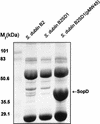Secreted effector proteins of Salmonella dublin act in concert to induce enteritis
- PMID: 9826357
- PMCID: PMC108733
- DOI: 10.1128/IAI.66.12.5799-5804.1998
Secreted effector proteins of Salmonella dublin act in concert to induce enteritis
Abstract
The ability of enteropathogenic salmonellae to recruit inflammatory cells and induce secretory responses in the infected ileum is considered to be a main feature in Salmonella-induced enteritis. Interactions between the pathogen and intestinal epithelial cells result in a variety of cellular responses mediating inflammation and fluid secretion. It is becoming apparent that proteins secreted by the Inv-Spa type III secretion system of Salmonella spp. play a key role in the induction of these responses. We have recently demonstrated that the SopB effector protein is translocated into eukaryotic cells via a Sip-dependent pathway and mediates inflammation and fluid secretion in infected ileal mucosa. However, SopB did not appear to be the only effector involved, as inactivation of the sopB gene only partially impaired enteropathogenicity. We suggested that at least some of such protein effectors are likely to be proteins of the same class as SopB, i.e., secreted effector proteins translocated into eukaroyotic cells via a Sip-dependent pathway. In this work, we identify SopD, another secreted protein belonging to the family of Sop effectors of Salmonella dublin. Using the cya reporter system we showed that SopD is translocated into eukaroyotic cells. We assessed the potential involvement of SopD in enteropathogenicity and found that inactivation of sopD has an additive effect in relation to the sopB mutation.
Figures






References
-
- Fu Y, Galán J E. The Salmonella typhimurium tyrosine phosphatase SptP is translocated into host cells and disrupts the actin cytoskeleton. Mol Microbiol. 1998;27:359–368. - PubMed
-
- Galán J E. Molecular genetic bases of Salmonella entry into host cells. Mol Microbiol. 1996;20:263–271. - PubMed
-
- Galyov E E, Wood M W, Rosqvist R, Mullan P B, Watson P R, Hedges S, Wallis T S. A secreted effector protein of Salmonella dublin is translocated into eukaryotic cells and mediates inflammation and fluid secretion in infected ileal mucosa. Mol Microbiol. 1997;25:903–912. - PubMed
Publication types
MeSH terms
Substances
Associated data
- Actions
LinkOut - more resources
Full Text Sources
Other Literature Sources
Miscellaneous

